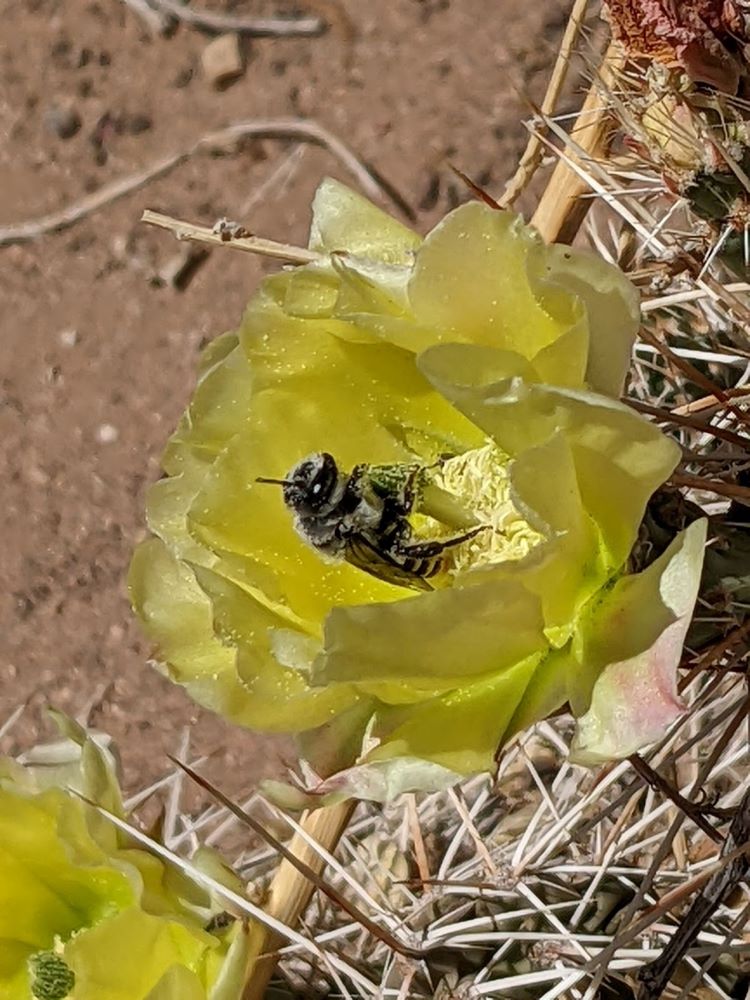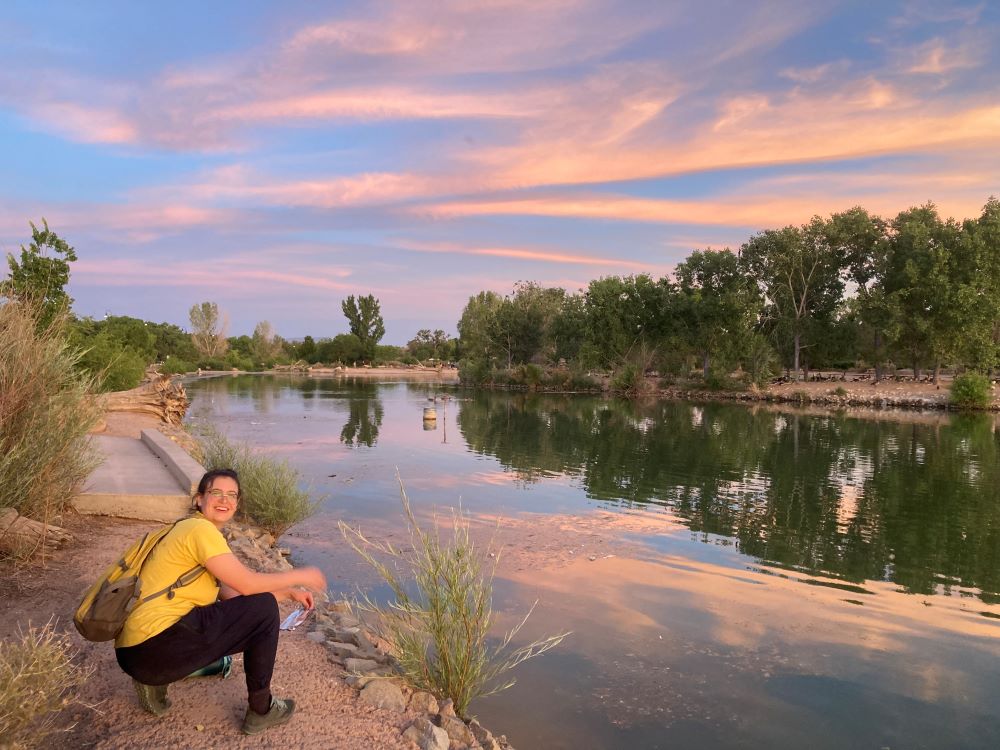There is a lot to celebrate in New Mexico during Pollinator Week, literally: it is home to some of the greatest diversity of bees and butterflies in the United States. New Mexico hosts about 40% of all butterfly species and a quarter of all of the bee species found in the US (approximately 300 and 1,000 species, respectively).
In a study of western butterflies, researchers from the University of Nevada Reno collected data from community scientists and found a 1.6% annual reduction in the number of individual butterflies observed over the past four decades (Forister et al 2021). The decline was associated with the warming and drying of the west. Habitat loss, pesticide use, invasive species and pathogens add further strain. While a 1.6% annual decline might not sound like much, remember it is compounded over time. The scientists who completed the study didn’t like the trend they saw.
Fortunately, simple actions like planting flowers and avoiding pesticides can help bring back the pollinators in real time. That truth is a key driver in Xerces’ New Mexico pollinator conservation efforts.
Growing the Santa Fe Pollinator Trail
Small patches of habitat in our communities are critical to conservation (Riva and Fahrig 2022). A small home garden or the corner of a city park dedicated to native flowering plants can offer the resources needed for many pollinators to survive and thrive.
To create more of these small pocket habitat sites, Xerces’ Southwest Conservation Specialist Kaitlin Haase runs a pollinator habitat kit program in Santa Fe that offers free native pollinator plants to residents and organizations. Her goal is to create a Santa Fe Pollinator Trail, a connected, climate-resilient pollinator habitat throughout the city. We see these small plots as stepping stones for bees and butterflies to be able to move throughout Santa Fe and expand their foothold.
The program offers plants that support all life stages of pollinators: pollen and nectar rich flowers to feed the bees and adult butterflies, as well as host plants that are the food of butterfly caterpillars. Last year Kaitlin and her partners were able to distribute 11,500 plants to over 250 residents and organizations. Later this summer, 250 habitat kits will be planted in Santa Fe at residential and public spaces, adding 8,250 pollinator plants to the Santa Fe Pollinator Trail. Program participants need only answer a few important questions through the habitat kit interest forms to be sure they can care for the plants and protect the habitat from pesticide contamination.

Photo: Emily Ruth Spindler. Cactus specialist bee on cactus flower. Almost half of the 1000 bee species in New Mexico are specialists, meaning that they only eat the pollen of a small group of plants.
Pesticide Sampling in Albuquerque to Protect Butterflies
This spring, Xerces expanded our work in New Mexico and I joined as the new Southwest Pesticide Program Specialist. One of my first tasks was to gather data to better understand pesticide contamination in the towns and cities where we’ll be working to establish habitat. Along with my fellow Xercoids (how we refer to ourselves) and with support from Matt Forister from the University of Nevada Reno, we designed a simple project to test butterfly host plants for pesticides. The project also includes testing in Sacramento, California to build on an earlier project we completed looking at pesticide contamination in milkweed growing in California’s Central Valley.
As summer began, my Xerces colleague Aimee Code joined me in Albuquerque to sample plants. We rolled out of bed at the break of dawn to begin before the overwhelming desert heat set in, searching for common native plants that are also butterfly host plants – globemallow, horsetail milkweed, sunflower, false indigo, desert willow, and coyote willow.
Over three days, we visited public parks, open spaces, and the backyards of Xerces supporters. (Thank you for welcoming us into your gardens!) As we scanned the sites for butterfly host plants, we saw lots of native pollinators and other wildlife. Cactus flowers were laden with bees collecting pollen for their young, and the desert willow (genus Chilopsis) was buzzing with a variety of bee species. Some were only a few millimeters in size, while others were huge. The bumble bees and large carpenter bees were almost an inch in length. We also saw a marine blue butterfly (Leptotes marina), a road runner, numerous jack rabbits, and a bright red bird (maybe a tanager) that zipped by overhead early the second morning.
 Emily Ruth Spindler samples for pollinators in New Mexico (Photo: Aimee Code, Xerces Society)
Emily Ruth Spindler samples for pollinators in New Mexico (Photo: Aimee Code, Xerces Society)
Seeing so many pollinators out foraging was a good sign. And through this sampling project we will further our understanding of whether pesticide use in the area is compromising these important homes for urban wildlife. After wrapping up at sunset, we packed up the samples with ice and shipped them overnight to a lab at Cornell for analysis. We will have results later this year to see if butterfly host plants are contaminated with pesticides.
Eliminating Home Pesticide Use is Key to Pollinator Survival
Beyond field work like this sampling project, a major part of my job is supporting people’s efforts to take the small and effective steps that help conserve the unique and diverse pollinators of New Mexico. The recipe for success is pretty simple and it works everywhere: grow pollinator-friendly flowers, provide nest sites, avoid pesticides, and spread the word.
When it comes to avoiding pesticides, use in and around homes can’t be discounted. According to the US Environmental Protection Agency, 25% of insecticide use in the US is residential. Fortunately, a few tips can help you meet the goal of avoiding pesticides:
- Right plant, right place. Always place plants in areas with favorable conditions. Does the plant like more or less light? Does the plant like more or less water? What soil pH does it need?
- Go native. Native plants are well adapted to their area and as such are often less vulnerable to pest issues.
- Seek out bee-safe plants. Let your nursery know you want plants free of harmful pesticide contamination. Nurseries are more likely to make investments in pollinator-friendly production if their customers make it clear this is what they want.
You can read more in our guidance Smarter Pest Management: Protecting Pollinators at Home.
We all play a role in maintaining our world’s delicate balance. And our daily choices can make a difference in pollinator conservation. So, if you haven’t already, join us this Pollinator Week. Take some time to observe the pollinators in your neighborhood, check in with your local nursery to see if they offer bee-safe plants, or maybe share seeds and flowers with your friends.
In my role at Xerces, I am often reminded of the delicate desert balance: the water that brings bountiful life to our riparian areas, the cottonwood and willow leaves that rustle in the wind and feed the butterfly caterpillars, and the butterflies and bees that pollinate the vibrant desert wildflowers. There is so much we can do to protect the unique and fragile desert ecosystems. I find abundant hope among the people with deeply rooted care.



